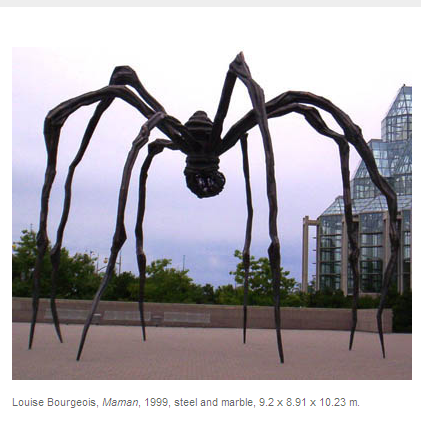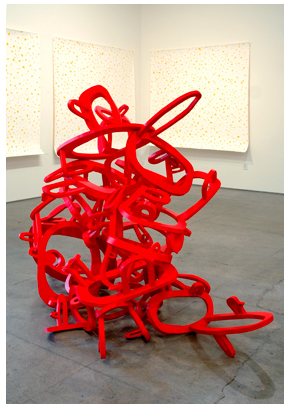Bourgeois, a French woman, was a famous artist who died from a heart attack on at 98 years old. She had a painful childhood experience which became “the grist to her mill of artistic”. Her mother died when she was eight and this affected her psychologically.
Bourgeois started her career in art in the late 1940’s after moving to New York. Her art express the theme of loneliness, anxiety and betrayal. Most of her work was constructed from scrap metal and wood which she used to curve sculptures, in he fifties, she made transitions from metal and wood sculptures to marble, plaster and bronze (McCrae 1).
Her sculpture, Maman, is one of the largest and the most impressive sculptures in the world. It was first displayed outside the Tate museum in 2000. The idea of the sculpture comes from the strength of her mother which means “spinning, nurture, weaving and protection”. Maman is 30 feet tall and 9 meters female spider made from stainless steel.
Under its belly it carries 26 eggs, arguably for protection, which are pure white marble. The spider itself is black in color, and Louise made sure that the placements of the legs of the spider were strong so as to support it.
She gave it a mystical character because the eggs the spider holds give it a sense of vulnerability and it also brings out the sense of her protective nature. To some the sculpture is fantastic while to others it is scary and that its presence brings back painful memory to her (McCrae 1).

Source: McCrae, Trisha. Louise Bourgeois. Maman: From the Outside In. 15 April 2000. Web.
Bourgeois artwork is related closely to Wojick’s work. The ideas relating to overcoming personal struggle that I found present in Wojick’s pieces were even more apparent in Bourgeois’s work. The majority of Bourgeois’s work relates to her early childhood experiences and shows a sexual and dark side of art.
She believes that a key part of art is a about “expressing struggling, loneliness and pain.” Her sculptures of massive spiders take a phobia held by many and amplify it, by making a normally small creature in to a large and powerful creation.
Visual response

Source: Wojick, Amanda. Amanda Wojick: Scuptures. 2009.Web.
A large part of her work takes sculptures of body parts intertwined that suggests a very sexual nature. This suggests Bourgeois was sexual abused at a young age and now deals with this pain by expressing it within her artwork. I found Bourgeois’s use of pain and struggling in her artwork interesting and decided to pursue it more.
Art sometimes amazes me, this spider looks like a real life giant spider dominating its surrounding with power and dignity. This was Bourgeois’s of showing her personal appreciation for her mother, and showing an intimate relationship she shared with her mother.
I agree with analysts that this spider is both metaphorical and symbolical that it “a gigantic spider acting as Bourgeois’s transitional space”. In a complicated way, Bourgeois had to choose a spider, a small but threatening creature.
This spider reminds me of a movie, “The Eight Legged Freaks” directed by Ellory Elkayem in 2002. Giant spiders developed to become “gigantic spiders” as a result of exposure to toxic waste. They become perfect killing machines.
I sense a lot of similarity because the movie was dedicated to the producer’s mother who died of cancer. Spiders are very protective and can become very poisonous and harmful. Coming closer to the spider’s legs, you can feel the safety and maternal presence felt by the huge white marble eggs. This is the same feeling you get when you read Bourgeois’ ode to her mother:
The Spider is an ode to my mother. She was my best friend. Like a spider, my mother was a weaver. My family was in the business of tapestry restoration, and my mother was in charge of the workshop. Like spiders, my mother was very clever.
Spiders are friendly presences that eat mosquitoes. We know that mosquitoes spread diseases and are therefore unwanted. So, spiders are helpful and protective, just like my mother (Findlay and Mallabar 2)
In her art, it’s evident that Bourgeois’s dependency on her past life is a significant source of her inspiration. Like a small child, she continuously relies on her mother to offer her “a shoulder to cry on”.
Works Cited
Findlay, Ruth and Daisy Mallabar. Tate acquires Louise Bourgeois’s giant spider, Maman. 11 January 2008. Web.
McCrae, Trisha. Louise Bourgeois. Maman: From the Outside In. 15 April 2000. Web.
Wojick, Amanda. Amanda Wojick: Scuptures. 2009.Web.